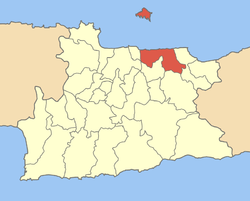Gouves, Greece
| Goúves Γούβες | |
|---|---|
 View of Kátó Goúves beach | |
| Location | |
 Goúves | |
| Coordinates | 35.3134°N 25.3134°E / 35.3134°N 25.3134°ECoordinates: 35.3134°N 25.3134°E / 35.3134°N 25.3134°E |
Location within the regional unit  | |
| Government | |
| Country: | Greece |
| Administrative region: | Crete |
| Regional unit: | Heraklion |
| Municipality: | Hersonissos |
| Population statistics (as of 2001)[1] | |
| Municipal unit | |
| - Population: | 7,761 |
| Other | |
| Time zone: | EET/EEST (UTC+2/3) |


Goúves (Greek: Γούβες) is a town and former municipality in the Heraklion regional unit, Crete, Greece. Since the 2011, local government reform it is part of the municipality Hersonissos, of which it is a municipal unit.[2] It lies a few kilometers east of Heraklion.
Goúves proper is often confused with its busy summer resort, Kátó Goúves. Besides this well developed tourist resort with long sandy beaches, the area has some traditional villages and archaeological sites and Eileithyia caves. West of Goúves are the tourist resorts of Kokkíni Háni (also spelled Háni Kokkíni) and Amnísos, both with similar attractions, and, to the east, Crete's largest resort, Hersonisos.
Goúves proper is located about 20 km (12 mi) east of Heraklion. Kátó Goúves, just a couple km north of the village, with its long sandy beach, is the summer resort. There is a variety of accommodation, from large hotels to boarding houses and self-catering apartments, and there are many restaurants, bars, nightclubs, and shops.
Within a short distance are picturesque villages and sights, such as the monastery of Saint John "Theologos", the Skotino cave and Eileithyia cave cave. The most important archeological sites of the area are the Minoan villas of Kokkíni Háni and Amnísos.
Monastery of Saint John Theologos
This monastery (Agios Ioannis Theologos in Greek) lies in a verdant setting Southeast of the village of Anópoli. It used to be part of the Saint George (Agios Giorgios) monastery, which is located to the North, which was abandoned following the frequent pirate raids in the 15th and 16th centuries and all the monks moved to the monastery of Saint John. During the Ottoman occupation of Crete, the monastery hosted Cretan revolutionaries and a secret school, something that lead the Ottomans to destroy it and kill the monks and the people of Anópoli in July 1896. The monastery was founded again some years later.
Skotino cave
This cave, one of the largest and more impressive among the hundred caves in Crete, is located high on a hill northwest of the village of Skotinó, a few kilometers inland south of Goúves. It is also known as Ayía Paraskevi cave, this name coming from the church built on top of it. The cave is 160m deep and 36m wide. The first archaeologically researches on the site were done by Arthur Evans, the well-known British archaeologist who unearthed and partially restored Knossos in the early 20th century. A more comprehensive exploration was done by French and Greek archaeologists in the 1960s.[citation needed] They found a considerable number of bronze and ceramic votive offerings, the oldest of them dating from the earliest Minoan periods, suggesting the cave was an important sacred shrine dedicated to a female fertility deity, presumably Britomartis. The cave was still used in Classical Greek and Roman eras, when the fertility goddess Artemis or her Roman equivalent Diana replaced the Minoan deity.
Minoan villa of Kokkíni Háni
The summer resort of Kokkíni Háni lies in Vathiano Kambo, about 13 km East of Heraklion and Northwest of Goúves. At the spot known as Nirou Háni, archaeologists found a well preserved Minoan villa dating from the New Palace period. The villa had two storeys, was about 1000 sq. meters large and had all the typical features of the Minoan architecture: two paved courts, connecting corridors, storage rooms, light wells, shrines, etc. About 40 tripods and huge double axes were found in some rooms, suggesting that the owner of the villa might have been a high priest. Like most of the Minoan buildings, the villa was destroyed by a big fire. The finds from the excavations are now displayed in the Heraklion Archaeological Museum.
Amnísos
Amnísos and its long sandy beach lies about 7 km East of Heraklion city, just beside the airport and in front of the islet of Dia. There is another Minoan villa in the area dating from 1600 B.C., where some frescoes that are now in Heraklion Archaeological Museum were found.
Eileithyia cave
This cave lies 1 km inland from Amnísos. It was an important sanctuary since Neolithic times. It was dedicated to Eileithyia, a Greek goddess of fertility and childbirth of Cretan origin. The cave is rectangular, 64m long and 9-12m wide. After the entrance there is an antechamber, which leads to a rectangular room surrounded by cylindrical stalagmites which were probably worshipped by the pilgrims. At the cave's mouth there is a square, known as "The Square of Altars". This courtyard may have been used in ceremonies. The cave remained in use until late Roman times.
References
- ↑ De Facto Population of Greece Population and Housing Census of March 18th, 2001 (PDF 793 KB). National Statistical Service of Greece. 2003.
- ↑ Kallikratis law Greece Ministry of Interior (Greek)
Bibliography
- Fisher, John and Garvey, Geoff (2007). The Rough Guide to Crete, 7th edition.
External links
- GouvesOnline website
- Gouves Travel Guide from traveleye.com
| ||||||||||||||